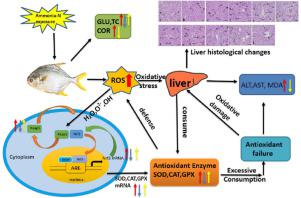Aquatic Toxicology ( IF 4.1 ) Pub Date : 2021-09-24 , DOI: 10.1016/j.aquatox.2021.105969 Ming-Jian Liu 1 , Hua-Yang Guo 2 , Ke-Cheng Zhu 2 , Bao-Suo Liu 2 , Bo Liu 2 , Liang Guo 2 , Nan Zhang 2 , Jing-Wen Yang 2 , Shi-Gui Jiang 3 , Dian-Chang Zhang 3

|
Continuous exposure to high levels of ammonia can cause oxidative damage to fish tissues and organs. To date, the mechanism by which juvenile golden pompano (Trachinotus ovatus) are poisoned by ammonia exposure has not been thoroughly elucidated. although the mechanisms of ammonia toxicity are not well described for the pompano, many other studies presented these effects to other fish species. So an overview would be given. First, an acute ammonia nitrogen toxicity experiment on juvenile golden pompano obtained a 96-h half-lethal concentration (96 h LC50) of 26.9 mg/L. In the ammonia exposure experiment, fish were sampled at 0 h, 6 h, 12 h, 24 h, 48 h, 72 h and 96 h after exposure to ammonia water (26.93 mg/L). The results showed that with the prolonged ammonia nitrogen exposure, plasma cortisol (COR), total cholesterol (TC), glutamic-pyruvic transaminase (ALT), glutamic oxalacetic transaminase (AST) and malonaldehyde (MDA) levels continued to rise, while glucose (GLU) levels first increased and later gradually decreased after 12 h. The activity of superoxide dismutase (SOD), catalase (CAT) and glutathione peroxidase (GPX) in the liver and the mRNA expression levels of antioxidant genes (SOD, CAT, and GPX) first increased and subsequently decreased with increasing exposure time. Through microscopic observation, it was found that the degree of liver damage increased with increasing stress time and was most serious at 96 h. In the post-poison recovery experiment, the fish exposed to ammonia were transferred to clean water, and samples were taken at 24 h, 48 h, 72 h and 96 h after recovery. The results showed that with the increasing recovery time, each index recovered to the initial level to varying degrees, but the recovery time of 96 h was not enough for the fish to return to the normal level. We also examined the regulation of the Nrf2-Keap1 signaling pathway by the molecular mechanism of the antioxidant defense system. The results of this analysis showed that there was a positive correlation between Nrf2 and liver antioxidant gene expression levels, while there was a negative correlation between Keap1 and liver antioxidant gene expression levels, which may be observed because Nrf2 plays a key role in inducing antioxidant genes, and Keap1 may hinder the response to Nrf2. These results may provide a deeper and more comprehensive understanding of the impact of ammonia exposure on fish and help to provide a foundation for managing the healthy reproduction of juvenile fish.
中文翻译:

急性氨暴露和恢复对幼年金鲳 (Trachinotus ovatus) 抗氧化反应和 Nrf2-Keap1 信号通路基因表达的影响
持续接触高浓度的氨会对鱼的组织和器官造成氧化损伤。迄今为止,幼年金鲳 ( Trachinotus ovatus)的机制) 是否因接触氨而中毒尚未得到彻底阐明。虽然对鲳鱼的氨毒性机制没有很好地描述,但许多其他研究表明这些影响对其他鱼类。所以会给出一个概述。首先,对幼年金鲳的急性氨氮毒性实验获得了 26.9 mg/L 的 96 小时半致死浓度(96 小时 LC50)。在氨水暴露实验中,在暴露于氨水(26.93 mg/L)后的 0 h、6 h、12 h、24 h、48 h、72 h 和 96 h 对鱼进行采样。结果表明,随着氨氮暴露时间的延长,血浆皮质醇(COR)、总胆固醇(TC)、谷丙转氨酶(ALT)、谷氨酸草酸转氨酶(AST)和丙二醛(MDA)水平持续升高,而葡萄糖 (GLU) 水平先升高,然后在 12 小时后逐渐降低。肝脏中超氧化物歧化酶(SOD)、过氧化氢酶(CAT)和谷胱甘肽过氧化物酶(GPX)的活性以及抗氧化基因(SOD、CAT和GPX)的mRNA表达水平随着暴露时间的增加先升高后降低。通过显微镜观察发现,肝损伤程度随应激时间的增加而加重,以96 h最为严重。中毒后恢复实验中,将暴露于氨水中的鱼转移到清水中,分别在恢复后24、48、72、96小时取样。结果表明,随着恢复时间的增加,各指标均不同程度恢复到初始水平,但96小时的恢复时间不足以让鱼恢复到正常水平。我们还通过抗氧化防御系统的分子机制检查了 Nrf2-Keap1 信号通路的调节。本次分析结果表明,Nrf2与肝脏抗氧化基因表达水平呈正相关,而Keap1与肝脏抗氧化基因表达水平呈负相关,这可能是因为Nrf2在诱导抗氧化基因中起关键作用。和 Keap1 可能会阻碍对 Nrf2 的响应。这些结果可以更深入、更全面地了解氨暴露对鱼类的影响,并有助于为管理幼鱼的健康繁殖提供基础。我们还通过抗氧化防御系统的分子机制检查了 Nrf2-Keap1 信号通路的调节。本次分析结果表明,Nrf2与肝脏抗氧化基因表达水平呈正相关,而Keap1与肝脏抗氧化基因表达水平呈负相关,这可能是因为Nrf2在诱导抗氧化基因中起关键作用。和 Keap1 可能会阻碍对 Nrf2 的响应。这些结果可以更深入、更全面地了解氨暴露对鱼类的影响,并有助于为管理幼鱼的健康繁殖提供基础。我们还通过抗氧化防御系统的分子机制检查了 Nrf2-Keap1 信号通路的调节。本次分析结果表明,Nrf2与肝脏抗氧化基因表达水平呈正相关,而Keap1与肝脏抗氧化基因表达水平呈负相关,这可能是因为Nrf2在诱导抗氧化基因中起关键作用。和 Keap1 可能会阻碍对 Nrf2 的响应。这些结果可以更深入、更全面地了解氨暴露对鱼类的影响,并有助于为管理幼鱼的健康繁殖提供基础。本次分析结果表明,Nrf2与肝脏抗氧化基因表达水平呈正相关,而Keap1与肝脏抗氧化基因表达水平呈负相关,这可能是因为Nrf2在诱导抗氧化基因中起关键作用。和 Keap1 可能会阻碍对 Nrf2 的响应。这些结果可以更深入、更全面地了解氨暴露对鱼类的影响,并有助于为管理幼鱼的健康繁殖提供基础。本次分析结果表明,Nrf2与肝脏抗氧化基因表达水平呈正相关,而Keap1与肝脏抗氧化基因表达水平呈负相关,这可能是因为Nrf2在诱导抗氧化基因中起关键作用。和 Keap1 可能会阻碍对 Nrf2 的响应。这些结果可以更深入、更全面地了解氨暴露对鱼类的影响,并有助于为管理幼鱼的健康繁殖提供基础。











































 京公网安备 11010802027423号
京公网安备 11010802027423号